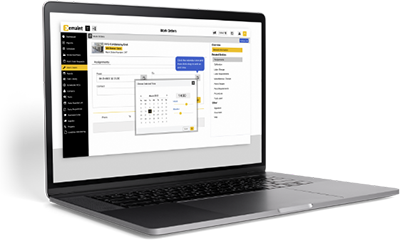 Understanding the Work Order
Understanding the Work Order
A work order system should clearly lay down a solution that allocates the least amount of time and energy to problems in asset maintenance. Individual work orders can be differentiated into on-demand or preventive types.
An example of on-demand is having a fan for air circulation that stops spinning one day. Conversely, an example of preventive is adding oil to an air compressor. Either way, you’ll need to be proactive about flagging down minor issues that could potentially escalate into a major breakdown.
When preparing maintenance work orders, spell out the instructions for your technicians and what spare parts to use on the affected equipment. Make sure they are taking safety precautions seriously by wearing PPE before arriving at the site. If they cannot find the source of failure, give them access to manuals and documents that disclose the machine’s status.
How to Fill Out a Work Order
In general, there are several parts to a work order template that enable maintenance workers to write authentic, error-free work orders.
Asset Name
Identify the equipment that has to be worked on. Fill in the ID of the asset undergoing maintenance and the priority rating if applicable.
Work Order No.
Each work order should have its own sequential number for the vendor to track its progress and see what tasks are complete.
Request Date/Time
Informs you of when the work request was submitted and gives a timeframe of the expected due date.
Scope of Work
What are the tools and parts you will use to perform the job? What skills and qualifications are required?
Department
It shows who wrote the work order and the department it was sent from.
Asset Description
Describe the asset’s current condition by what was seen, heard, or smelt to justify procedural maintenance.
Assign To
Who has an opening in their agenda to do the work? Consider bringing in a third-party contractor if specialized repairs are deemed necessary.
Placing a Work Order
The state of a monitored asset will tell you whether or not a request should become a mandatory order. You’d have to assess the criticality level, available budget, and severity of a report to figure out what the job entails. Make sure you have a thorough checklist of all the items set aside for each work order. One of them could be on electrical maintenance, so the mechanic can detect a faulty breaker box or a shut-off generator.
The important thing is to ensure your team has the skills and equipment to deal with every type of scenario that could disrupt your organization’s key infrastructure.
Work Order Function
Work orders are documents authorizing the tasks to be completed by maintenance, plant inspectors, general contractors, or field services. Most manufacturers use them to scope out the root cause after a routine audit. This shouldn’t be confused with a purchase order where you tally up the costs of goods and services rendered from outside vendors.
They are an effective method for collecting data on the usage of labor or part resources. Besides obtaining various failure indicators, you can plan ahead for emergency restorations and replacements through corrective measures.
Manage Work Orders
A work order management system is best implemented while using SOPs designated for each task. It is designed to process large volumes of requests by standardizing the forms with an attached document to help retain accurate data.
The six steps in the work order flow can be summed up as:
- Task identification
- Work order creation
- Work order approval
- Priority assignment
- Distribution and execution
- Result Documentation
For complex workflows, it is best to manage them through a CMMS which comes installed with a work order scheduling app.
Work Order Apps
A CMMS will make the maintenance work order process a breeze by keeping records of your cumulative maintenance and repair history so that every user receives the same version of those documents. The software utilizes cloud computing to support direct communications between team members on a central portal where technician requests are submitted through custom forms to automate the scheduling of PMs.
Many work order apps can be reached from both desktop and mobile devices in case the technicians are in the middle of repairing heavy-duty equipment or inspecting for signs of wear. Not only that, you also get insights into your operations thanks to real-time tracking of asset conditions, alerting the entire plant of what tasks are due for a checkup.
Above all, track the outcome of approved work orders by measuring insights like the overall equipment effectiveness to achieve your plant’s maintenance goals.
